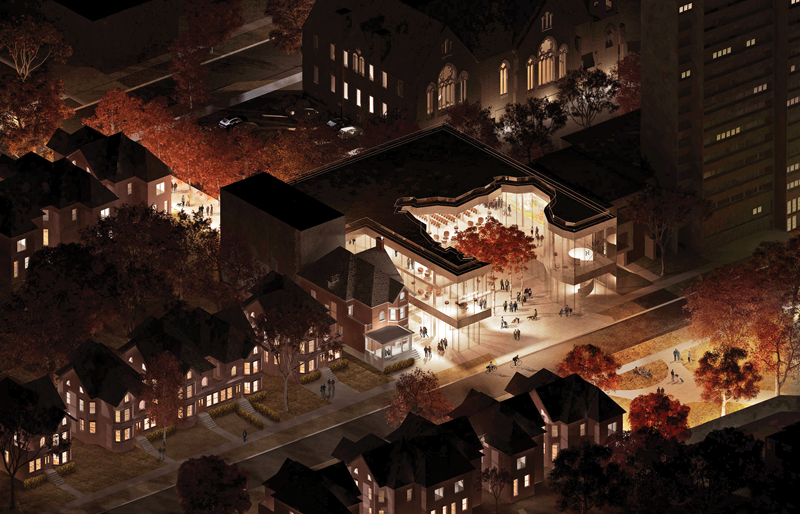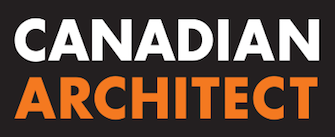International Estonian Centre
Kongats Architects
WINNER OF A 2018 CANADIAN ARCHITECT AWARD OF MERIT
Located on the Bloor Cultural Corridor in central Toronto, the International Estonian Centre hosts a series of spaces for the Estonian community and opens its doors to the general public for performances, public lectures and film festivals. The facility includes a cafe, library, sauna, art studio, classrooms and administrative offices. Its flexible main hall seats up to 330 guests for performances and conferences, and is divisible into three private rooms to host smaller events. On the ground floor, a credit union and an accelerator space for digital start-ups adjoin a pedestrian- and cyclist-friendly public courtyard. The facility incorporates and renovates a designated heritage mansion.
 The building is structured as a series of stage-like platforms enclosed by a luminous curtain made of glazing and cast foamed-aluminum panels. The choice of foamed aluminum makes a material reference to the Estonian New Year’s tradition of bleigiessen, in which lead drippings are used to forecast the year ahead. The building’s serrated form, which takes the shape of Estonia’s landmass, picks up on the zigzag rhythm of the residential facades along Madison Avenue. The irregularity of the form and the varying scales of the serrations provide the opportunity for pause along the curtain wall, allowing for quieter encounters and engagement among users.
The building is structured as a series of stage-like platforms enclosed by a luminous curtain made of glazing and cast foamed-aluminum panels. The choice of foamed aluminum makes a material reference to the Estonian New Year’s tradition of bleigiessen, in which lead drippings are used to forecast the year ahead. The building’s serrated form, which takes the shape of Estonia’s landmass, picks up on the zigzag rhythm of the residential facades along Madison Avenue. The irregularity of the form and the varying scales of the serrations provide the opportunity for pause along the curtain wall, allowing for quieter encounters and engagement among users.
 The building’s durable materials and attention to detailing give it an elegant, landmark quality in keeping with nearby architectural and cultural destinations, including the University of Toronto, Bata Shoe Museum, and Royal Ontario Museum.
The building’s durable materials and attention to detailing give it an elegant, landmark quality in keeping with nearby architectural and cultural destinations, including the University of Toronto, Bata Shoe Museum, and Royal Ontario Museum.
 As befits a country known as one of the world’s most advanced digital societies, the interior spaces are technologically sophisticated, ensuring the facility will remain flexible for future users. Sustainability is a key value for Estonians, so the building generates energy on-site, recycles greywater, employs a high-performance building envelope with triple-pane glazing and operable windows, and uses in-floor water-sourced heating and cooling. Exterior spaces incorporate permeable pavers. A west-facing, accessible rooftop terrace adds to the facility’s sustainability goals and presents additional green space in this dense urban neighbourhood. The site is well-serviced by public transit at the intersection of two subway lines, and next to a new crosstown cycling lane, providing strong alternatives to automobile access.
As befits a country known as one of the world’s most advanced digital societies, the interior spaces are technologically sophisticated, ensuring the facility will remain flexible for future users. Sustainability is a key value for Estonians, so the building generates energy on-site, recycles greywater, employs a high-performance building envelope with triple-pane glazing and operable windows, and uses in-floor water-sourced heating and cooling. Exterior spaces incorporate permeable pavers. A west-facing, accessible rooftop terrace adds to the facility’s sustainability goals and presents additional green space in this dense urban neighbourhood. The site is well-serviced by public transit at the intersection of two subway lines, and next to a new crosstown cycling lane, providing strong alternatives to automobile access.
 As a mid-rise development with three levels above grade, the centre acts as a buffer between the high-rises towering up to 20 storeys on Bloor Street and the historic residences along Madison Avenue. The east-west orientation of the facility ensures that the centre’s courtyard has sunlight through all four seasons. The courtyard and a through-block connection relieve foot traffic along Bloor Street and invite public use, in keeping with a City of Toronto planning initiative to animate the area’s side streets.
As a mid-rise development with three levels above grade, the centre acts as a buffer between the high-rises towering up to 20 storeys on Bloor Street and the historic residences along Madison Avenue. The east-west orientation of the facility ensures that the centre’s courtyard has sunlight through all four seasons. The courtyard and a through-block connection relieve foot traffic along Bloor Street and invite public use, in keeping with a City of Toronto planning initiative to animate the area’s side streets.
Download Project PDF
Jury Comments
David Penner :: This project sits comfortably on the site and will become a positive contribution to the neighbourhood. Using the existing heritage house as a transition to the adjoining neighbourhood is effective in responding to the larger urban fabric of the Annex.
Monica Adair :: How can a building help to create an identity through a formal gesture? While narrative is directly translated into the shape of this building’s facade and courtyard, it goes beyond simply the object itself to yield compelling spaces, creating a unique identity and a sense of place. Inside, the form-generator results in unique spaces that could be otherwise indulgent.
Ted Watson :: This project successfully mediates the scale between a residential environment and the tall buildings on Bloor Street. It leverages its site location to the west to achieve something very difficult—engaging a park space across the street. So many cultural centres are fortresses, and in contrast, this creates a welcoming public space.
Credits
CLIENT:: International Estonian Centre Inc.
LANDSCAPE:: North Design Office
HERITAGE:: Robyn Huether Architect
STRUCTURAL:: Entuitive
MECHANICAL/ELECTRICAL/AV:: Smith + Andersen
SUSTAINABILITY:: Footprint
CIVIL:: MGM Consulting Inc.
COST:: Altus Group
ACOUSTICS/VIBRATION:: RWDI
GEOTECHNICAL/SHORING:: Terrapro
PLANNING:: Bousfield
TRAFFIC:: LMM Engineering
AREA:: 36,000 ft2
BUDGET:: Withheld
STATUS:: Design Development, preliminary contract documents
ANTICIPATED COMPLETION:: 2021
View within Canadian Architect magazine’s December 2018 Awards Issue:
